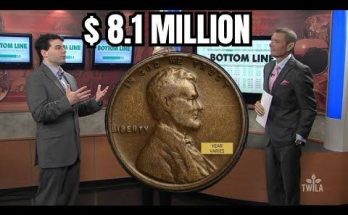The headline is shocking: “Unbelievable! 2019 Nickel Worth MILLIONS – Check Yours Today! – Coins Worth Money Look For This.” Can a modern, high-mintage Jefferson Nickel from 2019 really be a million-dollar treasure? While “millions” may be an attention-grabbing exaggeration, the underlying truth is a thrilling secret known to coin collectors: Minting Errors can transform a five-cent coin into a five-figure—or even higher—fortune.
For modern coins like the 2019 Jefferson Nickel, value doesn’t come from rarity due to low mintage (millions were struck in Philadelphia ‘P’ and Denver ‘D’ that year). Instead, the astronomical values are created by dramatic, verifiable, and highly sought-after Minting Errors and Varieties. These are the accidental masterpieces of the minting process, and a few truly incredible finds from recent years show that a massive fortune could be hidden in your pocket change.
The Hidden Value: Modern Mint Errors
The image in the caption directs your attention to the Jefferson Nickel, a coin that has been in continuous production since 1938. While most of these coins are worth face value, those struck with a significant error or anomaly are the modern-day lottery tickets.
Here are the key errors and varieties to look for on a 2019 Nickel:
1. The Full Steps (FS) Designation
The most consistently valuable variety for the Jefferson Nickel isn’t an error, but a perfect strike. On the reverse side of the coin, the steps leading up to Monticello are often worn down or poorly struck, even on uncirculated coins. A Full Steps (FS) designation by grading services like PCGS or NGC means all five central steps are clearly visible and separated, indicating an exceptional, early-strike coin.
- Why it’s rare: Achieving a “Full Steps” designation is incredibly difficult, especially on modern nickels where die degradation is common.
- Value: While not worth “millions,” a 2019 Jefferson Nickel graded MS-66 (Mint State, high grade) or higher with the Full Steps designation can trade for hundreds of dollars—a staggering return for a five-cent coin!
2. Die Errors: The Million-Dollar Mistakes
The most valuable modern finds are often the result of significant production failures. These are the errors that can theoretically drive a coin’s value into the thousands of dollars, and perhaps one day, a world-record-breaking sale:
- Die Chips and Cuds: A Die Chip is a small piece of the coin die that breaks off, causing a raised lump on the coin’s surface. A Cud is a larger, more dramatic chip that involves the rim and an adjacent area of the coin, creating a blank, raised area. Look for chips on Monticello or on Jefferson’s portrait. The more dramatic the error, the more valuable the coin.
- Struck-Through Errors (The ‘Smoking’ Jefferson): This occurs when a foreign object (like a piece of wire, cloth, or grease) falls onto the coin blank (planchet) before it is struck. The die presses down on the object, leaving an incused, or recessed, mark on the coin’s surface. One popular type of struck-through grease error on nickels makes it look as though Thomas Jefferson is “smoking” a cigarette, which is a desirable novelty among error collectors and can fetch tens to hundreds of dollars.
- Double Die Reverse (DDR) or Obverse (DDO): This is one of the most famous and valuable coin errors. It happens when the die itself is struck twice by the hub at a slightly misaligned angle, causing a doubled image on the coin. While a major doubling error has not been formally classified for the 2019 nickel that commands millions, new discoveries are constantly being made. A noticeable, distinct doubling of the date, letters in “Liberty,” or the features on Monticello could instantly make a 2019 nickel worth hundreds or thousands of dollars to the right specialist.
Your Collector’s Checklist for the 2019 Nickel
Don’t spend your 2019 nickels yet! Here is your quick guide to a successful treasure hunt:
- Examine the Date: Use a magnifying glass (a jeweller’s loupe, $10-20, is best) to check the “2019” date and the surrounding letters for any clear doubling or smudging.
- Inspect Monticello: Turn the coin over and look at the steps. Are all five central steps clearly defined, separate, and complete? If so, you may have a “Full Steps” candidate. Also check the building’s windows for any chips or distortion.
- Check Jefferson’s Face: Look closely at his eye, forehead, and mouth for any unusual lumps (die chips) or flattened, smudged areas (struck-through grease). A distinctive “mark” can be a valuable error.
- The Rim: Look for a dramatic Broad Rim Error (where the coin appears to have an unusually wide edge) or an Off-Center Strike (where the coin’s design is not centered on the planchet). The more dramatic the off-center strike, the higher the value.
The coin world is full of surprises. While “millions” is a stretch for a 2019 nickel, finding an exceptional, highly-graded Full Steps coin or a truly dramatic Error Coin is absolutely possible, turning a five-cent piece into a highly valuable collectible worth thousands.
Would you like me to look up historical examples of Jefferson Nickel errors that have sold for the highest prices to illustrate the potential value of these mistakes?



